GALILEO
Investigation of the Magnetosphere of Ganymede with Galileo's Energetic Particle Detector
Ph.D. dissertation by Shawn M. Stone, University of Kansas,
1999.
Copyright 1999 by Shawn M. Stone. Used with permission.
Appendix B. The G7 Encounter Particle Trace Results
This appendix is dedicated to the G7 time-reversed particle trace results. The format of the results follows that of the G2 results in Chapter 6. These figures are referred to in Chapter 8.
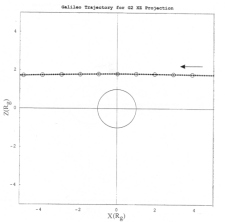 |
Figure B1 ZX projection of the G7 encounter in GSII coordinates. The circles along the trajectory are separated by five minute intervals, the first starting at 06:50:00 UT. |
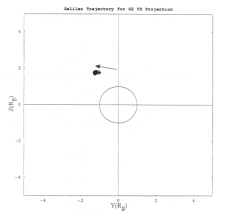 |
Figure B2 ZY projection of the G7 encounter in GSII coordinates. The circles along the trajectory are separated by five minute intervals, the first starting at 06:50:00 UT. |
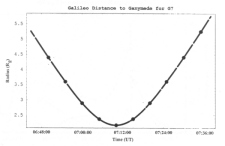 |
Figure B3 Radial distance to the center of Ganymede for the G7 encounter as a function of encounter time. |
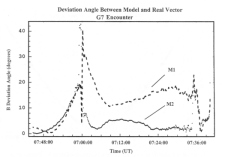 |
Figure B4 Angle of deviation between the measured magnetic field vector with that of the model field vector. |
 |
Figure B5 Model 1 field line tracing for the G7 encounter. The time in UT is indicated at each feature location. |
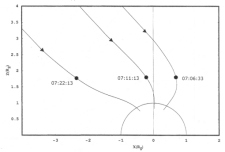 |
Figure B6 Model 2 field line tracing for the G7 encounter. The time in UT is indicated at each feature location. |
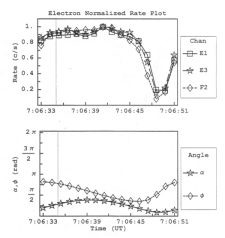 |
Figure B7 (A) Rate profile for feature G7-07:06:33 for the electrons as measured by the EPD instrument during the G7 encounter. (B) The pitch (a) and phase (f) values of the particles as measured by the EPD detector. |
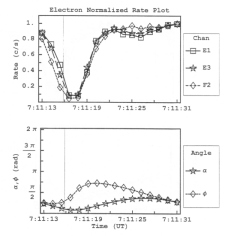 |
Figure B8 (A) Rate profile for feature G7-07:11:33 for the electrons as measured by the EPD instrument during the G7 encounter. (B) The pitch (a) and phase (f) values of the particles as measured by the EPD detector. |
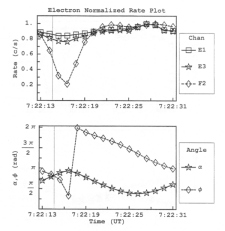 |
Figure B9 (A) Rate profile for feature G7-07:22:13 for the electrons as measured by the EPD instrument during the G7 encounter. (B) The pitch (a) and phase (f) values of the particles as measured by the EPD detector. |
Additional figures:
- M1 07:06:33 figures
- M2 07:06:33 figures
- M1 07:11:13 figures
- M2 07:11:13 figures
- M1 07:22:14 figures
- M2 07:22:14 figures
Next: Appendix C. Additional G2 Results
Return to dissertation table of contents page.
Return to main
Galileo Table of Contents Page.
Return to Fundamental
Technologies Home Page.
Updated 8/23/19, Cameron Crane
QUICK FACTS
Manufacturer: The Galileo Spacecraft
was manufactured by the Jet Propulsion Laboratory,
Messerschmitt-Bölkow-Blohm, General Electric, and the
Hughes Aircraft Company.
Mission Duration: Galileo was planned to have a mission duration of around 8 years, but was kept in operation for 13 years, 11 months, and 3 days, until it was destroyed in a controlled impact with Jupiter on September 21, 2003.
Destination: Galileo's destination was Jupiter and its moons, which it orbitted for 7 years, 9 months, and 13 days.
Mission Duration: Galileo was planned to have a mission duration of around 8 years, but was kept in operation for 13 years, 11 months, and 3 days, until it was destroyed in a controlled impact with Jupiter on September 21, 2003.
Destination: Galileo's destination was Jupiter and its moons, which it orbitted for 7 years, 9 months, and 13 days.



